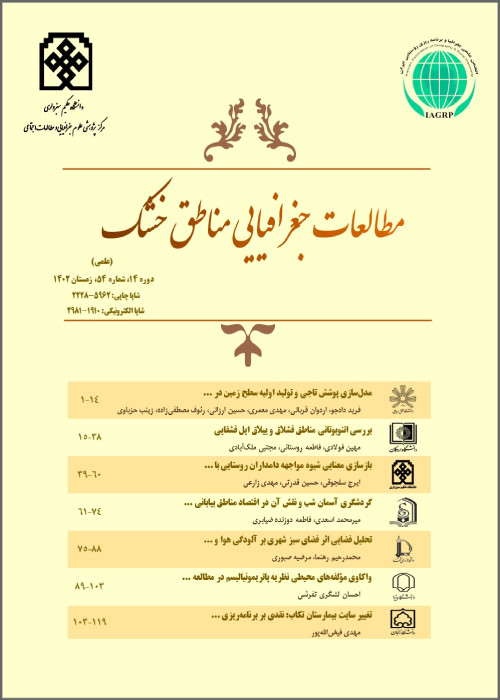Assessment of Climate Change Impacts on Runoff using WetSpa Model with Probabilistic Approach and Uncertainty Analysis (Case Study: Yellow River Watershed in Khozestan Province)
Author(s):
Abstract:
This study examines the effects of climate change on runoff in the Yellow River basin in Khuzestan province. In this study, the combination of 14 general circulation models under two emission scenarios A2 and B1 were used for simulating the climatic variables in the next period (2025-2054) compared to the baseline period (1971-2000). The weighting method of mean observed temperature precipitation (MOTP) was used for combining general circulation models. The combination of Change Factor and LARS_WG was used for downscaling model data and the distributed hydrological model of WetSpa was used to simulate rainfall-runoff process in the baseline period (1971-2000) and next period (2025-2054). The results showed acceptable performance of the WetSpa model in the simulation of rainfall-runoff process. Also results of the assessment of the effects climate change on temperature and annual precipitation in future periods suggest the expected increase in temperature and decrease in rainfall equal to 1.51 (1.3) °C and 7.17 (4.62) percent, respectively, under the medium emission scenarios A2 (B1). In addition, the results from the effects of climate change on runoff, suggests reducing the annual runoff equal to 14.53 (12.36) percent under medium emissions scenario A2 (B1). These results are consistent with an increase in temperature and decrease of precipitation. The results of this study can be used in the Yellow River basin water resources management and the optimal allocation of Jareh dam reservoir which is located at the outlet of the basin.
IntroductionLimited water resources and non-uniform distribution of precipitation in different parts of Iran on the one hand and rapid population growth and the increasing water demand on the other hand lead to take into account the operation and management of available water resources as one of the most important issues in water resources studies. Therefore, in order to achieve optimal water resources planning and management, understanding the components of hydrological phenomena such as precipitation and runoff is necessary. In addition, in order to proper management of water resources in the future, investigating the changes in watershed runoff and the input discharge to the dam reservoir under the impact of climate change is of utmost importance. The main aim of this study is to investigate the climate change effects on runoff in the catchment area by analyzing uncertainty.
Materials and MethodsThe study area is the Yellow River basin in Khuzestan province. The watershed area at the upstream of the Jereh dam is about 810 km2. Most parts of this watershed are mountainous, so that the highest point is about 3300 m and the average elevation is 1190 m above mean sea level. The Jareh storage dam is constructed at the downstream of this basin to supply the agricultural water demand for Ramhormoz plain with an area of about 22000 hectares, to control the floods of the Yellow river and Hydroelectric power generation equal to 48 Giga watt hours per year. Therefore, assessment of the effect of climate change on water resources in the basin is a very important issue for optimum reservoir management.
There are different methods to assess the effects of climate change that most authentic way is using the outputs of the general circulation atmosphere-ocean models (GCM). In this study, the combination of 14 general circulation models under two emission scenarios A2 and B1 from the SRES (Special Reports on Emission Scenario) scenarios collection of the fourth report of the IPCC were used for simulating the climatic variables in the next period (2025-2054) compared to the baseline period (1971-2000). The weighting method of MOTP was used for combining general circulation models. Although the GCM models are powerful tools to study the effects of climate change but they have a low spatial resolution, which is one of the weaknesses of such models. To overcome this weakness, in this study the combination of Change Factor and LARS_WG were used for downscaling models data. Also, in order to assess the effect of climate change on runoff, the distributed hydrological model of WetSpa was used to simulate rainfall-runoff process in this watershed.
Results and Discussion The results of the assessment the effects of climate change in future periods on monthly temperature indicates an increase in all of the months in the studied basin. Unlike temperature, the expected average monthly precipitation changes in future periods are irregular, as it has estimated incremental changes in some months and decreasing changes in some other months. The results of weighting the GCM climate models showed that the HadCM3 model in simulating the rainfall and the ECHAM5-OM model in simulating average temperature had the best performance. The results of evaluating the performance of LARS-WG model in simulating climate variables and WetSpa model in simulating runoff indicated that both models had a good performance. The results of investigating the effects of climate change on runoff, indicated a reduction in annual runoff under all three probability levels emission scenarios. So that the changes in annual runoff under the A2 scenario for combination scenarios of IS, MS and CS are estimated to be reduced 8.49, 14.53 and 20.17 percentage, respectively, while these changes under the B1 scenario for combination scenarios of IS, MS and CS are estimated to be reduced 5.3, 12.36 and 17.36 percentage, respectively.
ConclusionsAccording to the results of this study, it can be said that the Yellow River basin will experience more dry conditions under climate change. Thus, according to the predicted changes of runoff in future periods and also because of the limited available water resources across the country, in order to reduce the negative effects of climate change in the future, the water resources managers and planners should consider the climate change effects in their decisions to cope with water scarcity in the future. For this purpose, they should investigate the coping strategies, including improving the performance of water resource systems, changes in cropping pattern in this area, more accurately management on the release of dam reservoir and changing the operation of the Jereh dam in accordance with climate change effects.
IntroductionLimited water resources and non-uniform distribution of precipitation in different parts of Iran on the one hand and rapid population growth and the increasing water demand on the other hand lead to take into account the operation and management of available water resources as one of the most important issues in water resources studies. Therefore, in order to achieve optimal water resources planning and management, understanding the components of hydrological phenomena such as precipitation and runoff is necessary. In addition, in order to proper management of water resources in the future, investigating the changes in watershed runoff and the input discharge to the dam reservoir under the impact of climate change is of utmost importance. The main aim of this study is to investigate the climate change effects on runoff in the catchment area by analyzing uncertainty.
Materials and MethodsThe study area is the Yellow River basin in Khuzestan province. The watershed area at the upstream of the Jereh dam is about 810 km2. Most parts of this watershed are mountainous, so that the highest point is about 3300 m and the average elevation is 1190 m above mean sea level. The Jareh storage dam is constructed at the downstream of this basin to supply the agricultural water demand for Ramhormoz plain with an area of about 22000 hectares, to control the floods of the Yellow river and Hydroelectric power generation equal to 48 Giga watt hours per year. Therefore, assessment of the effect of climate change on water resources in the basin is a very important issue for optimum reservoir management.
There are different methods to assess the effects of climate change that most authentic way is using the outputs of the general circulation atmosphere-ocean models (GCM). In this study, the combination of 14 general circulation models under two emission scenarios A2 and B1 from the SRES (Special Reports on Emission Scenario) scenarios collection of the fourth report of the IPCC were used for simulating the climatic variables in the next period (2025-2054) compared to the baseline period (1971-2000). The weighting method of MOTP was used for combining general circulation models. Although the GCM models are powerful tools to study the effects of climate change but they have a low spatial resolution, which is one of the weaknesses of such models. To overcome this weakness, in this study the combination of Change Factor and LARS_WG were used for downscaling models data. Also, in order to assess the effect of climate change on runoff, the distributed hydrological model of WetSpa was used to simulate rainfall-runoff process in this watershed.
Results and Discussion The results of the assessment the effects of climate change in future periods on monthly temperature indicates an increase in all of the months in the studied basin. Unlike temperature, the expected average monthly precipitation changes in future periods are irregular, as it has estimated incremental changes in some months and decreasing changes in some other months. The results of weighting the GCM climate models showed that the HadCM3 model in simulating the rainfall and the ECHAM5-OM model in simulating average temperature had the best performance. The results of evaluating the performance of LARS-WG model in simulating climate variables and WetSpa model in simulating runoff indicated that both models had a good performance. The results of investigating the effects of climate change on runoff, indicated a reduction in annual runoff under all three probability levels emission scenarios. So that the changes in annual runoff under the A2 scenario for combination scenarios of IS, MS and CS are estimated to be reduced 8.49, 14.53 and 20.17 percentage, respectively, while these changes under the B1 scenario for combination scenarios of IS, MS and CS are estimated to be reduced 5.3, 12.36 and 17.36 percentage, respectively.
ConclusionsAccording to the results of this study, it can be said that the Yellow River basin will experience more dry conditions under climate change. Thus, according to the predicted changes of runoff in future periods and also because of the limited available water resources across the country, in order to reduce the negative effects of climate change in the future, the water resources managers and planners should consider the climate change effects in their decisions to cope with water scarcity in the future. For this purpose, they should investigate the coping strategies, including improving the performance of water resource systems, changes in cropping pattern in this area, more accurately management on the release of dam reservoir and changing the operation of the Jereh dam in accordance with climate change effects.
Keywords:
Language:
Persian
Published:
Arid regions Geographic Studies, Volume:7 Issue: 25, 2016
Pages:
76 to 94
magiran.com/p1710215
دانلود و مطالعه متن این مقاله با یکی از روشهای زیر امکان پذیر است:
اشتراک شخصی
با عضویت و پرداخت آنلاین حق اشتراک یکساله به مبلغ 1,390,000ريال میتوانید 70 عنوان مطلب دانلود کنید!
اشتراک سازمانی
به کتابخانه دانشگاه یا محل کار خود پیشنهاد کنید تا اشتراک سازمانی این پایگاه را برای دسترسی نامحدود همه کاربران به متن مطالب تهیه نمایند!
توجه!
- حق عضویت دریافتی صرف حمایت از نشریات عضو و نگهداری، تکمیل و توسعه مگیران میشود.
- پرداخت حق اشتراک و دانلود مقالات اجازه بازنشر آن در سایر رسانههای چاپی و دیجیتال را به کاربر نمیدهد.
In order to view content subscription is required
Personal subscription
Subscribe magiran.com for 70 € euros via PayPal and download 70 articles during a year.
Organization subscription
Please contact us to subscribe your university or library for unlimited access!




